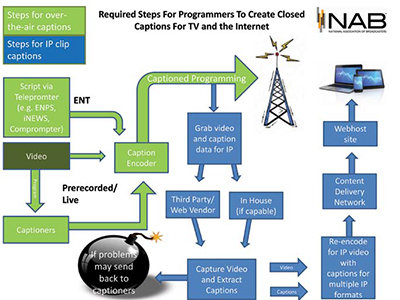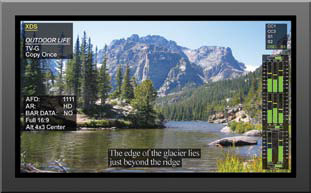FCC Pushes Caption Deadlines

Required steps for programmers to create closed captions for TV and the Internet.
WASHINGTON—Three new deadlines looming on the horizon are pushing the professional video industry to catch up on one of the quietest technologies in our midst: closed captioning.
Three deadlines—one in five months, another in 2016, the final in 2017— have been handed down by the Federal Communications Commission in order to provide smoother and more accurate closed-captioned communications across a wider-reach of programming.
But the requirements are being met with resistance from opponents who feel the deadlines are unrealistic, cumbersome and overly restrictive.
“I am concerned that expectations surrounding caption quality may exceed the practical ability of companies to deliver,” said Maria Browne, an attorney with Davis Wright Tremaine, a San Francisco law firm that follows media communications. “Companies with limited operating budgets will find it difficult to comply fully and immediately,” she said, pointing, for example, to the fact that captions for live programming can be impacted by any number of factors, including the clarity and pace of the captioned speech, the experience of human speech-to-text operators, or the current technological limitations of speech to text software.
Is the broadcast industry ready for all that?
There’s concern that the volume and significance of recent legislative changes may be overwhelming for many broadcasters and, as a result, “broadcasters may have not had sufficient time to internalize and develop a plan for monitoring caption accuracy,” said Drew Lanham, senior vice president of media for Nexidia in Atlanta.
Get the TV Tech Newsletter
The professional video industry's #1 source for news, trends and product and tech information. Sign up below.
‘A MANUAL PROCESS’
In the simplest of terms, the two FCC rulings extend the original closed-captioning rules that the FCC handed down in 2012 for online video. Fast forward to today, where both full-length online videos and short video clips must now be captioned, and that means broadcasters, cable and satellite distributors need to follow new rules if they plan to air programming on television and then post clips of that programming online.
There’s little debate on the merit of captions. Looking much as it did when closed captioning debuted in 1997, the simple scrolling text allows persons with hearing disabilities to have access to television programming in a relatively simple manner. Supporters point to side benefits: the ability to improve literacy and ease adoption of English for non-English speakers. This isn’t new ground for the FCC, as the commission handed down significant captioning requirements in the 1990s and then again in 2002.
And yet the move is stinging to some, particularly stations that may not be prepared with technology or personnel to handle this new batch of caption creation, who aren’t versed on the intricate new requirements, or who may be otherwise unprepared to handle the scalability challenge that lies ahead.
“Captions are pervasive in almost all phases of professional media production, and unlike other elements of the final product that can be checked using automated tools, [it] remains a manual process,” Lanham said.
Closed Captioning: What You Need to Know
What’s Happened:
Over the last six months, the FCC has handed down two new rulings that offer more specific guidance on closed captioning for online video. The upshot: there are new, specific rules for captioning full-length videos online as well as for online video clips. You got the gist of it: Except for a few exceptions, it all needs to be captioned, and under a stricter set of rules.

The Four Heavies in the Corner:
The FCC has highlighted four key guideposts for video distributors to follow. The goal is to ensure that captioning quality replicates the experience of television programming as much as possible. Under the new rules, all closed captions must be:
1. Accurate and reflect the dialogue, music and other sounds present in the programming;
2. Synchronized and able to match the video and audio content of the programming;
3. Complete and run from the beginning to the end of the program;
4. Appropriately placed on screen so as not to block other visual content.
The Deadlines You Need to Know:
2015: Those four above-mentioned quality-specific guidelines must be met by Jan. 15, 2015, with appropriate monitoring and maintenance plans in place. That means if your captioning goes haywire, you better have a backup plan.
2016: Clips lifted straight from a program and posted on to the Web, known as straight-lift clips, must be captioned starting Jan. 1, 2016.
2017: Montages of video clips must be captioned starting Jan. 1, 2017, with live (or nearly live) video clips such news or sports captioned by July 1, 2017.
What is Exempt: Video clips that are in your online library before the applicable compliance deadline, as well as programming that was not was not previously aired in the U.S. with captions. Also exempt is programming from Web-only video sites and consumer-generated media.
There are two key issues at hand: one, that captions must now be provided for full-length online videos that have been broadcast in the U.S.; and two, that four new quality checkpoints must be in place in an effort to improve the quality of the sometimes-jumbled and mismatched captioning universe. Those four specific requirements are accuracy, synchronicity, program completeness and positioning (see sidebar).
The new ruling also clarifies a number of grey areas: it untangles the captioning requirements for foreign languages and on-demand programming, confirms that the rules apply to LPTV stations, mandates that broadcasters take corrective measures in the event of captioning problems and requires that video programming distributors obtain certifications as to the exempt status of relevant programming.
The second FCC ruling in July required that short video clips be captioned as well, regardless of the length or content of the segment. The reasoning? Since consumers often bypass full-length video programming in favor of short-form news and spots clips, those must be captioned as well. With 77 percent of Internet users regularly watching video clips online, “It’s time to update our closed-captioning rules to reflect these changes,” said FCC Chairman Tom Wheeler when the ruling was announced. “With [this] item, we go further and require captioning for video clips that end up on the Internet.”
SOME EXCEPTIONS
The FCC squeezed in several caveats, though. Captions are only required on programming that aired with captions on television in the United States. The FCC also clarified that snippets of English or Spanish on programs that are otherwise in a different language do not need to be captioned.
The rules also impose new requirements on manufacturers of certain equipment that are designed to receive or playback video programming, such as set-top boxes, DVD players and tablets. But both the National Association Broadcasters and National Cable and Telecommunications Association have expressed a host of concerns over the new rulings, balking at the elimination of captioning exemptions, new formatting regulations and additional monitoring requirements.
“These definitions are overly restrictive, and unnecessarily intrude upon the ability of licensees to use commercially reasonable judgment to determine the timeframe and manner by which content can be edited and displayed to viewers,” the NAB said in formal comments to the FCC.
Other pitfalls noted by the NAB include unrealistic deadlines, unneeded quality requirements, unwelcome mandates on emerging technologies like 4K, and the fact that programmers might be held responsible for captioning clips that are not within their immediate control.
Particularly galling seems to be that the new rules do not extend to third-party organizations. The rules also don’t target sites like Netflix and YouTube, as their programming isn’t shown over the air. Consumer-generated media is also exempt.
“Third-party websites, by definition, operate independently and licensees and programmers have no control over a clip once it leaves the programmer’s website,” the NAB statement read. “Expecting the same level of quality when the clip is on a website operated by a third-party is unreasonable.”
Both NAB and NCTA also pointed to the need for flexibility to experiment with new innovations.
Opponents have also pointed to the fact that the new rules are cumbersome and restrictive, with the potential for fewer clips to be created because of the additional burdens. There are also the challenges of meeting a quickly approaching timeline. New quality guidelines must be met by Jan. 15, 2015; captions for online clips that are lifted right from a program must be raring to go by 2016; news and sports clips and segments that form a montage must be addressed by 2017.
While this may require equipment and personnel investments that the industry isn’t quite prepared for, the commission believes it’s time.
“Earlier this year, the commission acted to enhance quality standards for closed captioning on TV that had been languishing at the FCC for over a decade,” Wheeler said.
There’s more to come. The FCC is considering an additional ruling that will require closed captioning of video clips provided by third-party distributors as well as eliminate the grace period that now exists for captioning live programming clips. More tussles are expected when it comes to waivers, as the commission considers restricting the waiver process.
COMPLIANCE CONFUSION
Where does that leave things? Some are calling for a rollback of the restrictions; others are asking that the FCC shift the responsibility of captioning to a greater number of sources.

Bill McLaughlin
“[One problem] is that there is no single measure of whether your content is compliant with the quality ruling,” said Bill McLaughlin, vice president of product development for EEG Enterprises, a Farmingdale, N.Y.-based provider of captioning technology. Detractors point to confusing definitions of word accuracy, punctuation, timing and visual style. Add to that the fact that violations are initiated by viewer complaint, which may not always be based on an accurate understanding of the rules.
“There’s a lot to absorb,” he said. “It’s not something like CALM [the audio standard] where you can plug in a device that will measure whether you’re compliant and put full trust into that. The regulations have too many dimensions, and are not sufficiently quantitative to be handled that way.”
In addition to FCC fines, failure to meet these nonlinear distribution requirements will result in content rejections, delivery delays and lost revenues.

Jason Livingston
A number of manufacturers have stepped up to offer support around the issue, from Wohler to Nexidia to Telestream to EEG, which recently rolled out the newest extension of its iCap system, called CCPlay FilePro Live, a cloud-enabled captioning solution that works to caption short prerecorded clips. Other solutions like Nexidia QC are in place at Turner Broadcasting, where the technology is being used to automate quality control of closed captioning and video descriptions. Solutions like Mac-Caption and Post Producer software from Telestream help users ensure that edited clips and montages can automatically have the original captions preserved and correctly synced up with the edited clips.
“Some of the larger content creators are finally starting to see the value in providing quality closed captioning, and I hope that will be true for more and more content providers in the future,” said Jason Livingston, product manager for closed captioning for Telestream in Nevada City, Calif.
Susan Ashworth is the former editor of TV Technology. In addition to her work covering the broadcast television industry, she has served as editor of two housing finance magazines and written about topics as varied as education, radio, chess, music and sports. Outside of her life as a writer, she recently served as president of a local nonprofit organization supporting girls in baseball.

